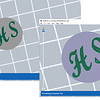To explain further, your nozzle cannot lay down a thread very well that is less than the nozzle size.
So if you have a part of your text there that is 1mm, and you are extruding .4mm, flashprint is going to leave a .2mm gap in your letter.
Likewise, if you have a part that is 1.8mm, and you print two shells, flashprint is going to print the two shells, and flashprint is going to leave a .2mm gap in your letter.
Cura, and some other slicers will force material in there, in effect compensating for that section.
S3D and Flashprint do not do this.
So if you have a part of your model that is 1.8mm, and you are printing at .4mm, and you use one shell, your software will print the outside shell, and then run fill into the inside. So it is all about how thick the “wall” is. For tiny walls, multipliers of your nozzle size print best. You can see examples in the knowledge base.
Now I am not taking into account other things here. With S3D, you can run horizontal compensation here, and add .1mm or so to get it to fill in. Or you can mess with changing your nozzle size (in the software) or extrusion multiplier a little, which will extrude a little more plastic, possibly filling in the missing material by squishing it in there. This will affect the quality of an otherwise perfectly dialed in print, however, as it might cause overextrusion in other parts of the model.
While it is true that you print small details like this successfully in the past, you just have not hit this exact math on a shape like this before, probably.
Depending upon the needed accuracy of the print, another thing you can do if Flashprint is not cooperating is laying down two models, and moving one over by .1mm or so, and then printing. This will make your print off round slightly, so may not be an option.
But long story short, you have to fiddle to get your nozzle to go into that open spot, and your slicer software can’t see how to do it without your help.
